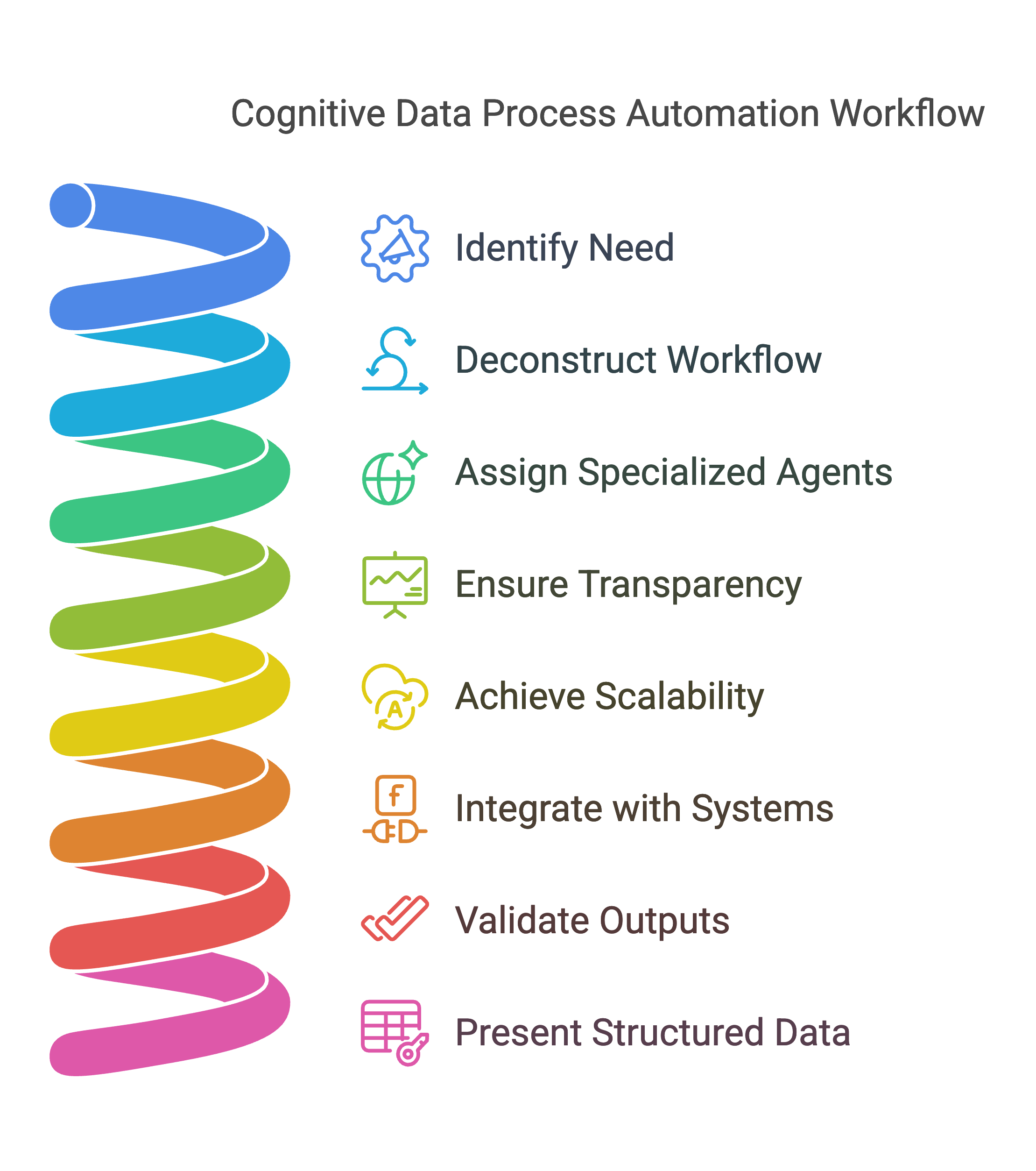Understanding Cognitive Data Process Automation (CDPA)
Artificial intelligence, particularly large language models (LLMs) and AI agents, is transforming how businesses approach data and document processing. Tools like ChatGPT and other out-of-the-box AI solutions are effective for general-purpose tasks, but they often fall short when applied to complex, high-stakes workflows. These models lack precision, scalability, and transparency—essential features for enterprise use or integration into mission-critical products.
Cognitive Data Process Automation (CDPA) bridges this gap by leveraging agentic workflows—a modular, purpose-built approach that goes beyond standard AI agents and generic LLMs. CDPA is designed to handle enterprise-scale challenges with precision and auditability, making it ready to integrate seamlessly into existing systems or innovative applications.
Why Agentic Workflows are Different
At the core of Cognitive Data Process Automation (CDPA) are agentic workflows, which deconstruct complex processes into smaller, specialized tasks managed by modular AI agents, facilitating data automation and enhancing efficiency. Unlike generic AI agents, these workflows are tailored for enterprise requirements, addressing critical limitations of out-of-the-box solutions:
Task Specialization: Each agent within the workflow is built for a specific function, such as data validation, enrichment, or reconciliation, ensuring high accuracy and reliability.
Transparency: Every step in the workflow is auditable, with real-time dashboards providing visibility into task progress and decision-making.
Scalability: Agentic workflows handle massive volumes of structured and unstructured data across diverse formats, including non-standard Excel files, PDFs, and scanned documents.
Integration-Ready: CDPA’s modular design allows it to embed into enterprise systems or products via APIs, enhancing functionality without disrupting existing workflows.
This tailored approach ensures that CDPA doesn’t just automate processes—it transforms them, enabling businesses to operate with confidence even in high-stakes environments.
How CDPA Combines Generative AI and Agentic Workflows
Generative AI, powered by LLMs, is an essential part of CDPA but operates within a structured framework. While LLMs excel at tasks like interpreting unstructured text, summarizing documents, or generating insights, CDPA’s agentic workflows ensure these outputs are validated, organized, and actionable.
For example, in a document-heavy process like contract analysis:
An LLM-powered agent extracts key clauses and terms from unstructured text.
Agentic workflows then cross-validate the extracted data against benchmarks, flagging discrepancies and ensuring compliance with regulatory standards.
The final output is presented in a structured, auditable format, ready for decision-making.
While this is a simplification of a simplified use case, it illustrates how agentic processes can succeed when workflows are designed and broken down into discrete tasks that includes validation.
This layered approach integrates the strengths of generative AI with the enterprise-grade reliability of CDPA, delivering results that are both scalable and trustworthy.
Real-World Applications of CDPA
Financial Data Reconciliation
Financial workflows often involve reconciling data from messy, non-standard Excel files and disparate systems, a challenge effectively addressed by cognitive data process automation. Using CDPA, these files are automatically ingested, cleaned, and normalized at scale. AI agents identify and resolve discrepancies while generating audit-ready financial reports.
This eliminates the inefficiencies of manual reconciliation, allowing teams to focus on strategic decision-making.
Supply Chain Data Integration
Supply chain operations generate vast amounts of data across logistics, inventory, and supplier management. CDPA can unify this data into a single, actionable view. Agentic workflows automate tasks like reconciling supplier invoices with shipment records and optimizing inventory levels.
This ensures seamless supply chain operations while reducing costs and delays.
ESG Compliance Reporting
Meeting sustainability standards like ESRS requires aggregating and validating diverse datasets, a process streamlined by cognitive data process automation through agentic workflows. CDPA simplifies this by combining LLM-powered document interpretation with agentic workflows that normalize and verify the data. It produces comprehensive, regulator-ready reports while maintaining a complete audit trail.
This enables organizations to meet compliance goals efficiently and accurately, showcasing the transformative potential of cognitive data process automation in modern enterprises..
Endless Opportunity
These examples only scratch the surface of what Cognitive Data Process Automation (CDPA) can achieve. Countless business processes across industries stand to benefit from scalable, intelligent automation. For instance, CDPA can enhance manufacturing operations by automating quality control checks and standardizing supplier data, or improve logistics by predicting demand and dynamically optimizing shipping routes. In finance, CDPA can power regulatory compliance audits or automate client portfolio updates. By addressing complex data workflows at scale, CDPA delivers transformative value across manufacturing, supply chain, finance, and beyond, helping organizations achieve greater efficiency and precision.
Why CDPA is Enterprise-Ready
Precision Where It Matters Most
Generic AI agents and LLMs often produce outputs that require significant post-processing to meet enterprise standards. CDPA solves this by embedding task-specific agents into workflows, ensuring precision at every step.
Built for Scale
Whether processing millions of documents or reconciling vast datasets, CDPA scales effortlessly. Its modular design allows it to adapt to growing business needs without compromising performance.
Transparency as a Standard
Unlike black-box AI models, CDPA’s workflows are fully auditable. Real-time dashboards display task progress, confidence scores, and flagged anomalies, making it easy for businesses to trust and refine automated processes.
Seamless Integration
CDPA’s API-first approach makes it ideal for embedding into existing enterprise systems or new products. This allows organizations to enhance functionality without overhauling their tech stack.
The Future of Data Automation
Cognitive Data Process Automation represents a fundamental shift in how enterprises handle data workflows. By addressing the limitations of generic AI tools and out-of-the-box LLMs, CDPA delivers a solution that is ready for the scale and complexity of modern business.
For enterprises in finance, sustainability, supply chain, and beyond, CDPA offers a smarter way forward—combining the power of generative AI with the reliability of agentic workflows.
Contact us today to learn how CDPA can transform your operations and elevate your data workflows.


